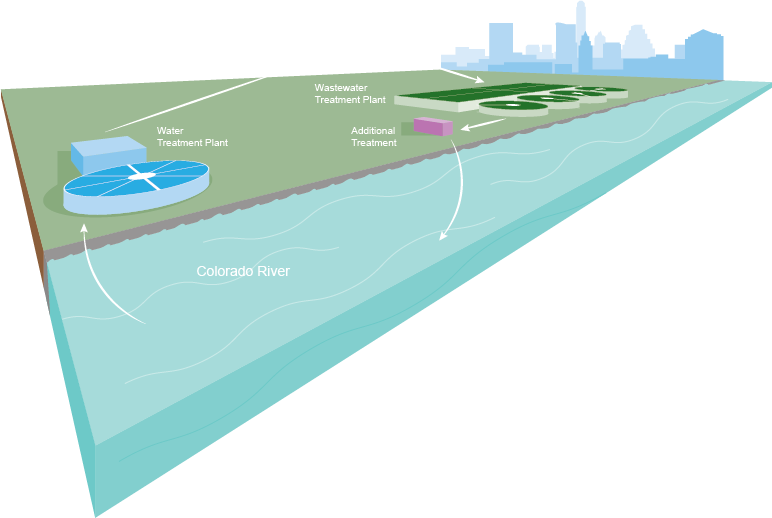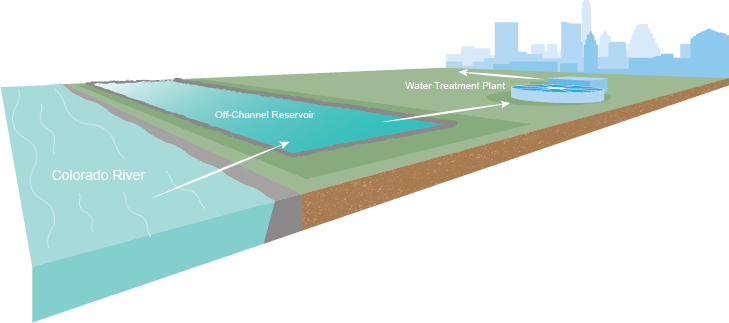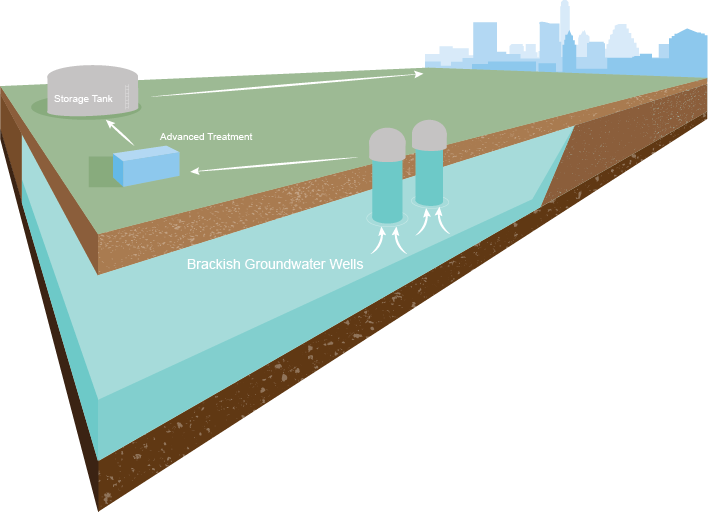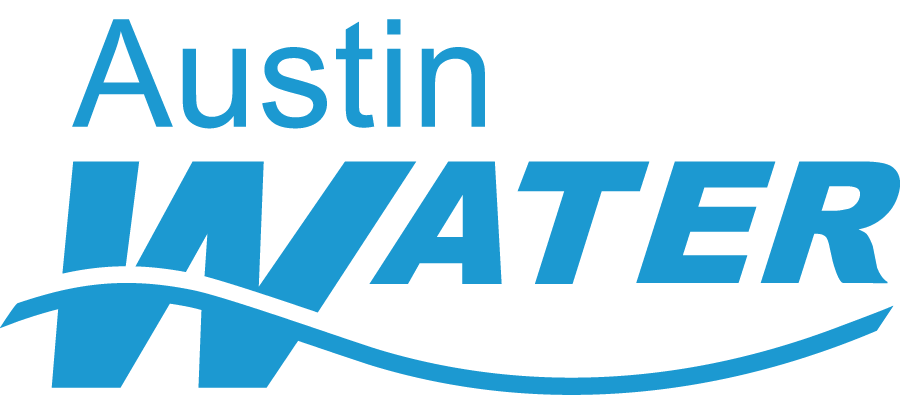One of the key drivers of the Water Forward Plan was the 2008-2016 drought, when inflows of water and combined storage volumes in Lakes Travis and Buchanan were at historic lows. The major water supply projects included in the plan are largely to augment Austin’s access to water during drought when core surface water supplies are limited.
Aquifer Storage and Recovery (ASR) is a water supply strategy to store available water for recovery and use when we need it most. In 2021, Austin Water began a study to determine if aquifers in our region could be used for an ASR project in the future.
Aquifer Storage and Recovery, also called ASR, is a water storage strategy in which water is stored in an aquifer during wetter periods and recovered at a later date. Storing water underground can improve drought preparedness in the same way storing water in a reservoir does, while eliminating the water loss due to evaporation that occurs in open above-ground reservoirs. To learn more about Austin’s ASR project, click on the ASR tab.
.png)
Indirect Potable Reuse, also called IPR, is included in Water Forward as an emergency water supply strategy for infrequent use during only the most severe drought situations. IPR would convey highly treated reclaimed water from a wastewater plant to Lady Bird Lake so it could be diverted for treatment to drinking water standards. The strategy is combined with the Capture Local Inflows to Lady Bird Lake strategy, which would use portions of the IPR infrastructure outside of severe drought conditions to capture local inflows from Barton Springs and other creeks. As included in Water Forward, these strategies are planned to be online by 2040.

Off-Channel Reservoir, or OCR, is a water storage strategy where a reservoir is constructed away from the main stem river and is filled by pumping water from the main river channel to the reservoir. This allows water to be stored during wetter times and used to supply drinking water during dry times. As included in Water Forward, this strategy will be online by 2070.

Brackish Groundwater Desalination is a strategy where salty groundwater is treated to drinking water standards. This strategy is a longer-term water supply strategy in Water Forward, with implementation by 2070.

About Aquifer Storage and Recovery
When water supplies are plentiful, an Aquifer Storage and Recovery system will store available drinking water in a natural aquifer underground. When regular water supplies become low during a drought or other emergency, the stored water is pumped out of the aquifer and tested and treated to meet Austin’s drinking water standards before it’s distributed to customers.

Project Background
From 2008-2016, a historic drought hit Central Texas, reducing water in the highland lakes to historically low levels. In response, Austin Water created Water Forward, a plan to guide Austin’s water future for the next 100 years. The Austin City Council-approved Water Forward plan includes conservation, reuse, and water supply strategies to ensure a diversified, sustainable, and resilient water future for Austin. Aquifer Storage and Recovery is one of the water supply projects included in Water Forward. An ASR system will help make Austin’s water supply more resilient through climate change and droughts and can provide a second source of water during emergencies, like freeze events or flooding. An ASR system will store water available under the City’s existing water rights, allowing Austin to maximize local water resources.
Preliminary ASR Project Process
Austin Water is currently studying aquifers in our region to determine their suitability for an ASR system in the future. Community engagement is a critical component of this ASR project. Upcoming community workshops will collect feedback on project guiding principles, equity and affordability considerations of ASR, and project evaluation criteria. Please check back throughout the project as we share preliminary results, collect feedback, and answer questions.
Austin’s ASR project is currently in the first phase of implementation. In Phase 1, Austin Water is working to select a consultant team to help identify sites for an ASR pilot project(s). Once sites are selected, Austin Water will perform piloting prior to development of a full-scale ASR project. Public outreach and stakeholder engagement will be an important of the ASR project.
The implementation approach for ASR will be adapted as needed as more information is gathered.
ASR Project Timeline (view timeline illustration)
- 2020-2023: Identify where to pilot
- 2024-2027: Design, construct, and test pilot; develop recommendations for full-scale ASR
- 2028-2029: Preliminary Engineering for full-scale ASR
- 2029-2030: Design for full-scale ASR
- 2031-2035: Construction of full-scale ASR
ASR Resources
Check out the links below to learn more and get involved!
- Submit your questions about ASR
- On-Demand Online Workshop: Aquifer Storage and Recovery
- Sign up for email updates
- View our Aquifer Storage and Recovery fact sheet (en español)
- Read the Water Forward Integrated Water Resource Plan
- See Texas Water Development Board ASR Resources
- Learn more about San Antonio’s ASR System
Frequently Asked Questions
- Will the Aquifer Storage and Recovery (ASR) project capture flood water?
-
No, Austin’s ASR project is not planned to capture flood waters. The ASR project will store drinking water from Austin's core supply source, the Highland Lakes. An ASR project for flood mitigation is not feasible due to infrastructure and storage requirements as well as cost.
- How will Austin protect the water that is stored in the ASR?
-
It is a priority for Austin Water to choose a location for the project that will allow us to protect the water that we store. AW will have control of the land above our stored water, but due to the early stage of the project, we have not yet identified specific strategies to achieve that. Other ASR projects, for example, have purchased the land above their stored water to protect it, and leased the land back to farmers or ranchers. Additionally, Texas Commission on Environmental Quality (TCEQ) requirements for ASR state that ASR projects must be able to maintain control over their stored water.
- Is ASR a project to develop groundwater?
-
No, the intent of Austin’s ASR project is not to take native groundwater but to store Austin’s existing water supplies for later use. Austin’s ASR project will not take out more volume of water than it puts into the aquifer, per TCEQ ASR requirements.
- Who is paying for this?
-
Austin Water will pay for this project over a number of years using strategies that allow us to finance large projects while keeping customer rates affordable. Austin Water’s debt management strategies have made it possible to address two competing needs – spending on improvements infrastructure for dependable water service while keeping water rates down and affordable for customers of all incomes. Securing near-zero percent interest loans also helps Austin Water fund major infrastructure projects at a tremendous cost savings for the utility and its customers.
- Why are you looking in Bastrop, Lee, and Travis Counties?
-
A review of all significant aquifers in Travis and the surrounding counties was performed to investigate characteristics beneficial for ASR projects. Some of those characteristics included: storage capability, potential well capacity, and groundwater regulations. Based on the characteristics, the Trinity and Carrizo-Wilcox aquifers in Bastrop, Lee, and Travis counties have the best potential for Austin’s ASR project.
For more information relating to aquifers and groundwater please click here.
- What type of water will be stored in the ASR project?
-
Austin’s ASR project is planned to store water from Austin’s drinking water system. Water for ASR will be treated before it goes in the ground to ensure compatibility with the aquifer and existing groundwater. When ASR water is recovered, it will be treated to be fully compatible with AW’s existing drinking water quality.
- Will water quality in the aquifer be impacted?
-
In the next stage of ASR development, we will do more detailed water quality testing through an ASR pilot project. This will let us characterize how the source water stored in the ASR will interact with native groundwater. Extensive water quality testing will be done to ensure compatibility.
- What effect will the ASR project have on neighboring wells?
-
Since we have not yet identified specific locations for ASR wellfield areas, we do not have data at this point on potential effects on adjacent wells. We understand from other ASR projects that overall water levels for adjacent wells typically increase when water is being added to the ASR and decrease when ASR water is being withdrawn. Austin’s ASR project will not withdraw (or recover) more water than was stored. This is an important issue and is something we will be considering as we move forward.
- How can I provide input on this project?
-
The ASR team will hold community meetings to share information and collect input on the ASR project and will attend meetings in the community throughout the project. Community engagement events will be conducted in the summer of 2022 to receive input on the criteria and weightings that will be used by the project team to evaluate different project alternatives.
We are also developing an Equity and Affordability Road Map and Tool to help implement the ASR project with an equity and affordability lens. These products will help guide our community engagement efforts along with determining potential equity impacts and mitigation options when evaluating ASR project configurations.

